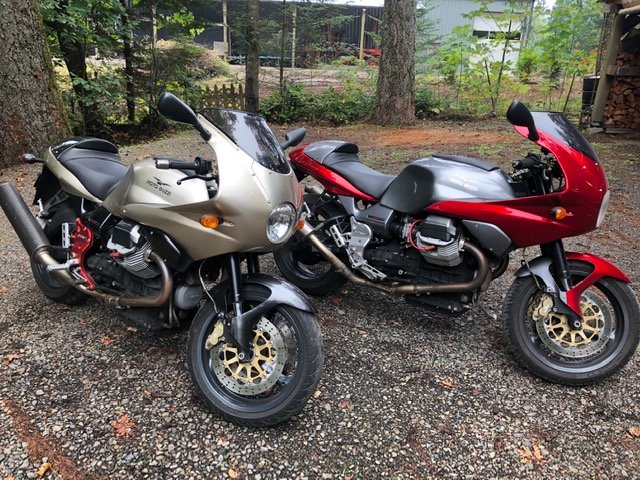-
Posts
625 -
Joined
-
Last visited
-
Days Won
16
Gmc28 last won the day on May 8
Gmc28 had the most liked content!
Profile Information
-
Location
West of Portland, Oregon
-
My bike(s)
02 LeMans (stable twins: 1 red/silver + 1 champagne), 99 Cagiva GC, '16 multistrada, ‘22 MG V85tt, Husky 501, Suzuki DR350/441, 50cc Vespa!
Recent Profile Visitors
24,018 profile views
Gmc28's Achievements

Forum-aholic (3/5)
679
Reputation
-
since there are other V85tt owners on this forum, figured i'd add a comment or two here on my ongoing relationship with the V85, for any that may be interested. Maybe take the liberty to have this be a little bit more of a V85tt thread. over the winter, i skipped the Guzzitech mods after some consideration (another story) and just did a SAS delete, Agostini exhaust/decat, added the heated grips via the popular mod from WildGuzzi (popular aftermarket slip-on heated grips which we tie into the factory switch), and a few other odds and ends, and all worked out great. Just an incredibly pleasant bike. Still doesn't strike me as a beautiful machine, but one of the best all-around machines i've owned, based on my current perspective (which has been known to change...). i'm done taking her off-road, other than gravel and such, for while she handled all that just fine last year, it was cruel abuse, and I'm just happier on a real off-road bike when on single track and fire roads. win-win. next i'll likely go for the fork cartridge inserts/upgrades, that were well spoken of at John Day last year by other V85-ers. front end is ok, but would benefit from some upgrade. the rear hugger fender i sourced from a chinese site works well, but the mounting setup is crap. It won't fall apart, but its hokey, so will noodle a better way to attach it. Fyi for anyone interested in a hugger. I live on a gravel road, so tend toward those kind of mods more than i would if I didn't live on gravel. i've mostly had (and have) older bikes, so was mildly shocked to learn that AF-1 had gas tank body work for sale, new-in-box, to match factory paint scheme. for a couple hundred bucks i was able to clean up the cosmetic damage (replace it) from the rash the previous owner did to it. the damage is what helped me get the bike at a great discount, which i figured i'd just live with, but was a cheap fix and she looks like new.
-
some great weather for that shot (and ride). none of the birds I work with or fly are as sexy as the fighter or the older birds that Chuck gets to play with. Well, not since we had to retire the DC-7's... they were lovely old gals. (captured here by someone at an opportune time with the lightning).
-
heck yes…. been on my bucket list for while, to get over to the motherland to tour, for the beautiful scenery, family roots, and the decent handful of nordic guzzi folks over there, like Tom! But playing tour guide for my own family on recent visits has cramped my riding options. eventually will work it in.
-
Or i think i’ll put the license plate on one of my odyssey batterys. Like a harley… larger and with less power, but thats ok because it’s heavy too!
-
hopefully i’m not straying too far from the OP’s thread title when i add a couple more non-Odyssey notes: Have been unable to get one of my Odyssey back to holding a charge, using the simple version of the discharge and charge cycle process noted here. Worked for another one, but i’ve got one approx 10yr old that isn’t responding well. I may need to read further to get beyond the caveman version of the process I had been using. but then, 2 Li-ion notables: one back from the dead (maybe old news to some, but was new for me), and another one performing after 8+ years… As noted elsewhere here, myself and Murphy combined to create the perfect snake-eyes roll, when I put a new Earth-X battery in my 1200 Duc, which after cringing at what i paid for it, then after riding it for about a week and leaving it down south at a friends place, had a relay failure causing a complete discharge of the expensive Li-ion Earth-x, down to 1.4 volts. To use the scientific term, killed it deader-n-hell. After replacing it with regular Batteries Plus sourced AGM (all i could find locally there) I looked at the Earth-X forlornly on the bench for the last several months. It wouldn’t take a charge from any of the various chargers I have, not surprisingly, but including my old-school bulk charger. But then I got a reminder/tip from one of our A&P’s at work: jumper the battery with another charged battery, then connect the smart charger. The smart charger will see enough voltage from good battery to begin its process, then disconnect the good battery, and see what happens. I did it out in the gravel driveway, as there was no guarantee things wouldn’t get out of control on the batt temp. But voila… it’s back. holding full voltage for several days now. (will load test it later this week) Then, one of the old riding mowers battery died. On a lark I popped in an old Shorai Li-ion I had on the bench, which I had pulled out of my KTM 990 about 7 yrs ago, to replace it with an Odyssey, to make it, in my mind, more reliable for shipping it off to alaska for several years. that Shorai was in used condition when i bought the bike, and had been drained down to around 8v due to another issue on that KTM which took me years to find (via half-assed efforts, admittedly). I had charged it back up, but assuming that from such a deep discharge, and being old, that its days were numbered. But it held a charge nicely, and used it for little projects over the years. Now, at least 8yrs later, popped it into the old riding mower, and it worked like new. A couple of cold and warm starts on the old Briggs & Stratton were better then ever (lots of CCA on that Shorai). I don’t know how the charging system on the mower will treat the Li-ion, so i’ll be watching that. but a somewhat interesting data point regarding life span on an old Li-ion that had seen some abuse.
-
I’ll move this to another thread, but it would be interesting to hear where in MN that your grandfather came to. Plenty of scandinavians in Minnesota, hence the name of the NFL team and all that, but on the other hand its amazing how often and quickly I find a shared history and/or ancestry thread with the Norwegians I run into all over. That little town of Houston MN apparently was first really settled by a couple norwegians, the Omodt/Birkeland’s (a couple years after a civil war fellow started there), who my cousin in Oslo says were the “bridgehead to america” for a string of Norwegians that followed. We’re a bunch of immigrants, like most americans (or, arguably, all people)…. hope I don’t get deported! 😎 Aside from the lack of mountains, its some nice country, and a pleasant place to explore on a motorcycle. maybe some day.
-
only a shot glass… sounds like a fast-fingers trick was involved?
-
lovely indeed. Fall there I suppose, but how wet does it get around Canberra in the winter? I spent a couple days in Canberra about 5yrs ago, but was so busy it was a blur. Need a month or two off to tour around, or even more as it’s a helluva big country, and the areas I’d like to tour are spread all over. Just need that winning Lotto….
-
helluva setup there Tom! Just arrived in Minnesota tonight, tomorrow making the drive to Houston, Minnesota, to see where the norwegian ancestors came over to establish the "bridgehead to america" around 1850. Probably be more fun to be in norway in your garage.
-

Do you like to dive? tired of carrying tanks?
Gmc28 replied to p6x's topic in Special place for banter and conversation
other "air" in the tanks. rather than the usual nitrogen/oxygen/other mix, its a different concoction of gases to achieve certain things, like to avoid nitrogen narcosis at deep depths, or nitrox to allow for different dive times, etc. -

Do you like to dive? tired of carrying tanks?
Gmc28 replied to p6x's topic in Special place for banter and conversation
i've not done the puerto madryn, which sounds excellent. But I did my inital scuba training and first year or two of diving all in Alaska. I did it all drysuit, though others used thick wetsuits. Was a great way to learn, and a unique place to dive and see. I fondly recall the first real dive, where it was snowing, gray, miserable, and with the drysuit and insulation I needed about 45lbs on my belt plus 4 lbs per ankle, so i'm sweating, damn uncomfortable, feeling like a beached whale, wondering why i'm doing this, and then I backed into the water and voila, of course it all changed.... awesome. Now weightless, "cool" (no longer hot from the suit, nor freezing from the water), with Sea lions, schools of black cod, wrecked boats and airplanes, etc. Getting that drysuit dialed in was key. took some time and focus to get it just right... not so tight on the seals that its painful, but tight enough to not leak. did some mixed gas diving too. -

Do you like to dive? tired of carrying tanks?
Gmc28 replied to p6x's topic in Special place for banter and conversation
Good point. Though when staying submerged even in most tropical waters, the energy gets sapped fast to where i can get cold. But that’s where scuba diving, where slow and easy movements are name of the game, whereas with no weight belt with snuba I’ll bet the extra work to control buoyancy would keep the blood pumping more, and be warmer. -

Do you like to dive? tired of carrying tanks?
Gmc28 replied to p6x's topic in Special place for banter and conversation
So a smaller version of the old Snuba setup, right? almost bought a snuba for a Caribbean sail trip, but I had to cancel trip for work, and never pulled trigger. Just seems way easier for shallow, tropical diving than the tanks. But wondering about weight belts, and buoyancy control in that first 1/2-1 atmosphere of change, where we like to dive and where snuba would be the ticket . -

Good deed for the day.
Gmc28 replied to activpop's topic in Special place for banter and conversation
I don’t want to derail activepops thread here, but to indulge just a little more…. where’d you find tire irons with the axle nut wrenches on the ends for the husky? great idea… two large-ish tools combined into one. love that idea. Update: quick google search reveals lots of options… imagine that. It’s now dark and rainy, so i’ll get out tomrrow and check those axle nut sizes. my 501 I use on road as well, connecting sections of off-road, or to get home on all tarmac after days of going 1 direction off road, so i haven’t gone down the tubliss path, though i was going to on my former “all dirt” bike. I’m toying with a handlebar mount tool bag now for the 501, and a frame mounted tube for tire irons. problem on the 501 is lack of rear subframe to attach that tool cylinder. I used the slime product for years in mexico on our ATV’s, and basically 3/4 of the time it was all that was needed. seems like more often on the off-road 2-wheelers the flats can be more problematic and not sufficed with slime, mostly because it tends to only work well with the tubeless setups. -
i rented one of those large guzzi’s down near Joshua Tree a few years back, for a couple days of touring the park and other areas up north of there. I enjoyed it, preferring it over the Harleys i had way back. that said, they all fall into the same problematic category for me: they are the best type of bikes for cruising down the big highways, which is exactly where i do NOT want to be on a bike, except to connect to other non-highway roads.








